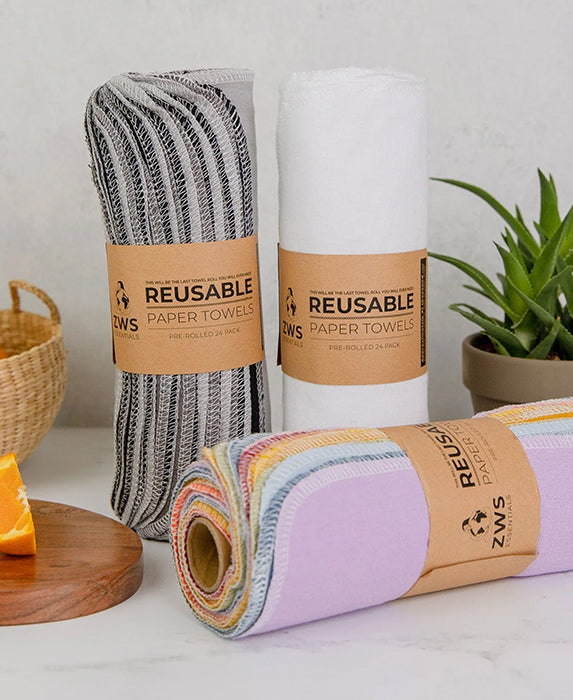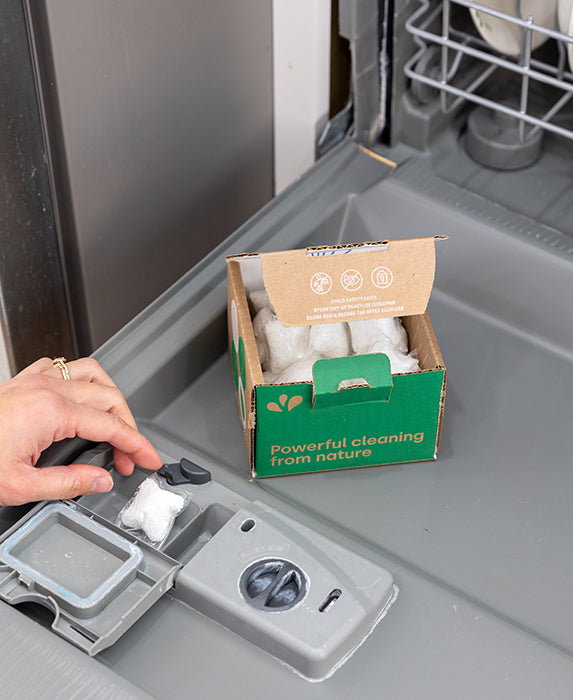You’ve likely heard the term ‘‘chemical-free’’ floating around the sustainability space – chemical-free shampoo, chemical-free soap, chemical-free detergent – but what does it actually mean?
In truth, it doesn’t mean a lot. Everything, from artificial fragrances to human beings (yes, us!) contains chemicals, so nothing is technically "chemical-free."
Some chemicals are naturally occurring, like oxygen, hydrogen, and flavonoids, which are crucial for the survival of the planet. After all, water is made from chemical compounds: 2 hydrogen and 1 oxygen!
Others are synthetic and made by humans for various purposes, like phthalates, sodium hypochlorite (bleach), and phosphates. It's this group that can be harmful, as many synthetic chemicals found in common cleaning, beauty products, and even fabrics have potentially toxic effects on human health and the environment.
So when you hear ‘‘chemical free’’, what it most likely means is ‘‘free from synthetic and potentially toxic chemicals, which pose a risk to our health and the health of our planet."
In this article, we’ll look at specific chemicals to give a little more context to the term ‘‘chemical-free’’ and some tips to go beyond buzzwords, and find out more about what you’re buying.
Chemical-Free Meaning
To reiterate, nothing is truly chemical-free, and so the term doesn’t have a literal meaning. Even if you only drank water, only used loose petals as perfume, and only ate straight from the trees, you would still be consuming chemicals!
That said, ‘‘chemical-free’’ is often used to indicate that a product is safe, non-toxic, and made from natural ingredients. That’s because, when we think of chemicals, the immediate association is synthetic and harmful ones.
So, no brand or product on EarthHero is technically chemical-free, but we do carefully vet everything on our marketplace to ensure it’s free from potentially harmful or toxic chemicals, and many of our products are free from any synthetic chemicals.
So more accurate descriptions are:
- Free from synthetic chemicals
- Free from potentially toxic chemicals
- Free from harmful chemicals
- Free from [name specific chemical groups]
Let’s break down the chemical-free even more, and decipher the chemicals we can’t (and don’t want to!) avoid, from the ones we should watch out for.
The Chemicals We All Have, Consume, And Need
Many chemicals are essential to life and support our overall health and well-being, including:
- Hydrogen, Oxygen, and Water (H2O)
-
Flavonoids
Antioxidant compounds found in fruits, vegetables, and flowers, supporting immune function and cardiovascular health. -
Polyphenols
A group of antioxidants that protect cells from damage and are commonly found in foods like tea, berries, and dark chocolate. -
Catechins
Powerful antioxidants found in tea, particularly green tea, known for their potential to improve heart health. -
Terpenes
Organic compounds found in essential oils and plants, often associated with potential medicinal benefits. -
Minerals (e.g., calcium, magnesium, potassium)
Essential for bone health, nerve function, and maintaining proper hydration levels. -
Electrolytes (e.g., sodium, potassium, chloride)
Crucial for regulating fluid balance, muscle function, and nerve signaling.
These naturally occurring chemicals are the building blocks of life, and we encounter them daily through the air we breathe, the food we eat, and the water we drink.
Natural Non-Toxic Products: Synthetic Chemicals To Watch Out For
On the flip side, many synthetic chemicals have been linked to harmful health effects and environmental damage. Here are a few synthetic chemicals that you’ll want to watch out for:
-
Phthalates
Commonly used in fragrances, plastics, and personal care products, phthalates are endocrine disruptors that can interfere with hormone levels, which may induce puberty, the development of cancer, and fertility disorders. -
Sodium Hypochlorite (Bleach)
Often used as a disinfectant in cleaning products, bleach can irritate the skin, eyes, and respiratory system. It also has a negative impact on aquatic life when it enters the water system. -
Phosphates
Found in some detergents, cleaning agents, and fertilizers, phosphates can cause water pollution, leading to harmful algal blooms and oxygen depletion in water bodies, affecting aquatic ecosystems. -
Parabens
Widely used as preservatives in cosmetics and personal care items, parabens can mimic hormones in the body, potentially disrupting normal endocrine function. -
Toluene
A solvent commonly found in paints, nail polish, and adhesives, toluene can affect the nervous system and cause headaches, dizziness, and nausea.
To protect your health and the planet, it’s best to steer clear of this list!
Deep Dive: ‘‘Chemical-Free’’ Sunscreens & Exfoliators
While the term "chemical-free" can be confusing, and isn’t accurate, it does hold some significance when it comes to product choices. This is particularly the case for sunscreens and exfoliators when it differentiates how the products do their job:
Mineral vs. Chemical Sunscreen
Sunscreens are often labeled as either "mineral" or "chemical", where mineral sunscreens contain natural ingredients that sit on the skin’s surface and block UV rays, and chemical sunscreens contain synthetic ingredients that absorb UV rays and convert them into heat.
Mineral sunscreens are generally considered a safer option, as chemical sunscreens can irritate the skin and contribute to coral reef damage.
But while many people choose mineral sunscreens as a ‘‘chemical-free’’ alternative, they’re still "chemical" because they’re made from natural mineral compounds. More accurately, they’re a non-toxic alternative.
Manual vs. Chemical Exfoliators
Exfoliating products are another example where "chemical-free" is often used, but the real difference is between manual exfoliators and chemical exfoliators.
Manual exfoliators use physical abrasives like sugar, salt, or scrubbing beads to slough off dead skin cells, which is what many people traditionally think of when it comes to exfoliation. These are natural, but still technically chemicals.
Chemical exfoliators, on the other hand, contain acids like AHAs (alpha hydroxy acids) and BHAs (beta hydroxy acids), which dissolve dead skin cells at a deeper level. These chemicals can be derived from natural sources like fruits or milk, or synthetic sources, which can irritate when overused.
How To Shop For Products Free From Non-Toxic Chemicals

At EarthHero, we prioritize products that are natural, non-toxic, and free from harmful synthetic chemicals, so you can enjoy the peace of mind that comes with knowing you're choosing safe, sustainable options.
For non-toxic laundry products, try: For non-toxic personal care products, try: For non-toxic cleaning products, try:If you’re shopping elsewhere, tools like EWG Skin Deep and Think Dirty App allow you to quickly plug in ingredients in any cleaning, skin, beauty, and personal care products and give them a rating based on toxicity.
3 Tips To Dig Deeper Than Vague Terms

Now we’ve busted the chemical-free myth, you’re probably thinking about other buzzwords floating around the sustainability space – green? natural? Organic? What does it all mean?!
While these terms can be a quick way to let you know the product is made with the planet in mind, they require you to dig a little deeper to uncover how exactly – the ingredients/ materials that go into it, and the brand’s sustainability initiatives.
Here’s some tips to get to the specifics:
Look for certifications
One of the easiest ways to verify a product's claims is by looking for trusted certifications, such as:
- Fair Trade Certified
- USDA Organic
- B Corp
- Leaping Bunny
- Carbon Neutral
- GOTS (Global Organic Textile Standard)
That said, getting certified can be expensive and inaccessible for small businesses, which brings us to number 2…
Get in touch
When in doubt, ask the company directly. Reputable brands should be transparent and open to answering your questions about their products and processes. If you have any questions about EarthHero, you can reach out here.
Read Ingredient and Material Lists
Get familiar with toxic and non-toxic ingredients, shop from brands you trust, or use the tools above to ensure you’re buying something that aligns with your values.
Final Thoughts – What Does ‘‘Chemical-Free’’ Really Mean?
At EarthHero, we always try to find the balance between showcasing sustainable products that genuinely excite us, while providing you with accurate and transparent information so you can make informed choices for yourself.
That involves clearing the fog around vague phrases like ‘‘chemical-free’’, so you can see clearly what they literally mean (not a lot, as everything contains chemicals!) and what they often intend to mean (free from synthetic and potentially toxic chemicals!).
We’ve also given you some tools and tips so that, when brands are ‘talking the talk’, you can triple-check that they’re ‘walking the walk’ and genuinely selling products that are safer for you, and less harmful for the planet.










